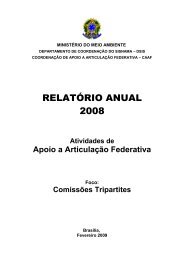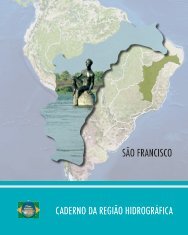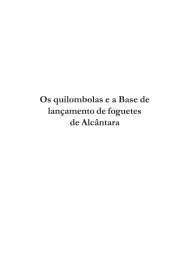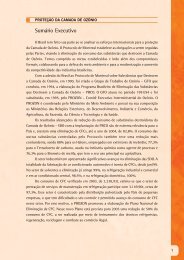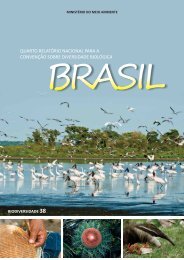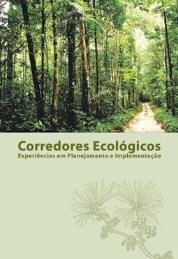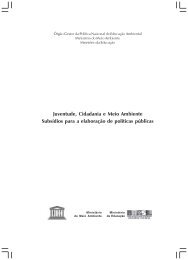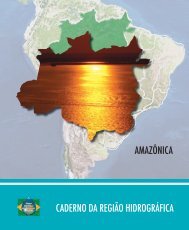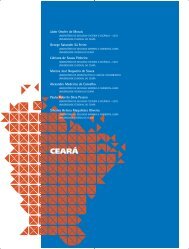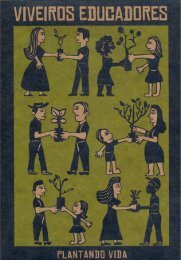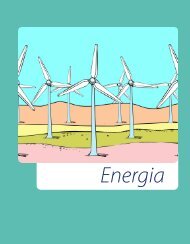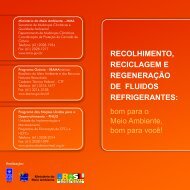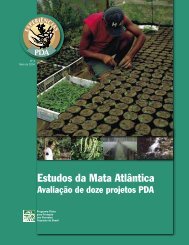Protected Areas
Protected Areas
Protected Areas
- No tags were found...
Create successful ePaper yourself
Turn your PDF publications into a flip-book with our unique Google optimized e-Paper software.
Atlantic ForestThe Atlantic Forest is one of the richestbiomes in terms of biodiversity inthe world and also the second mostendangered of destruction. 70% of theBrazilian population, 110 million people,lives in its domain. Hence, to live in theAtlantic Forest is a great privilege, butalso a big responsibility.History, Threats and OutlookThe destruction of the Atlantic Foreststarted in 1500 with the arrival of theEuropeans. All of the main economiccycles since the exploration of thebrazilwood tree, gold and diamondmining, cattle raising, coffee and sugarplantations, industrialization, woodexportation and, more recently, soya andtobacco plantations have dislodged, stepby step, the Atlantic Forest.There are still many factors that impactand contribute to the degradation ofthe Atlantic Forest, like: the growth ofunplanned cities, large scale projects,mining, advancement of agricultural andexotic tree monocultures planted withoutplanning, predatory shrimp farming andanimal trafficking.Considering the critical situation facedby the Atlantic Forest, several lawswere approved to protect, restore andpromote the sustainable use of thebiome. These laws, along with otherinitiatives, contributed to the reductionof deforestation levels by 70% in the lastdecade. Moreover, forest regeneration hasbegun in areas that were previously usedfor agriculture or cattle ranching.Where the Forest is LocatedThe Federal Constitution of Brazilestablished the Atlantic Forest as aNational Heritage. The forest covers,totally or partially, 17 Brazilian states.Originally the Atlantic Forest coveredapproximately 15% of the Brazilianterritory, an area equivalent to 1,300,000Km 2 , almost 4 times the area of Germany.Recent mapping showed the existenceof 27% of native vegetation cover in theAtlantic Forest, in relation to its originalarea, including all of the remainingforest areas and the vegetation of naturalgrasslands, coastal woodlands andmangroves. The well conserved forestremnants total close to 7% of the originalarea of the Atlantic Forest.Currently, more than 110 millionBrazilians are serviced by the watersthat spring from the Atlantic Forestand that form diverse rivers that supplyBrazilian cities and metropolises suchas Rio de Janeiro and São Paulo.The high levels of biological diversityfound in the Atlantic Forest make thisbiome extremely important in terms ofecosystem services. Safeguarding theseservices provides ecosystem sustainabilityand affords quality of life for humanbeings. Ecosystem services are benefitssupplied to people by ecosystems, suchas: water storage, rainfall generation,weather moderation, carbon fixation, soilconservation and the production of food,medicine and genetic resources.The Atlantic Forest also shelters a greatcultural diversity, composed of indigenouspeople, like the Guaranis, and nonindigenoustraditional cultures, likethe caiçara and the caboclo ribeirinho(fishermen communities), quilombolas(runaway slave communities) andtraditional subsistence farmers. Thetraditional communities depend on thenatural resources of the Atlantic Forestand most of them have developedsustainable systems of land-use.20



